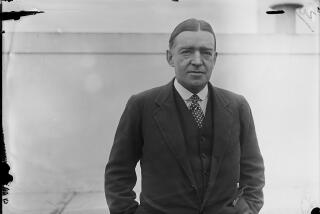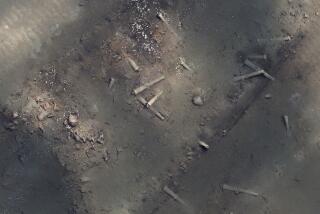Where Stephen Crane Traded In âRed Badge of Courageâ for âOpen Boatâ
ORMOND BEACH, Fla. â Ninety years after author Stephen Crane was shipwrecked off the Florida coast en route to Cuba, a group of divers claims to have discovered the sunken remains of the gunrunning vessel on which he sailed.
The remnants of what is believed to be the Commodore lie buried in Atlantic Ocean sand at a depth of about 80 feet, 12 miles east of Daytona Beach.
Although most wreck hunters seek treasure, a crew of weekend adventurers has been salvaging history since first coming upon the wreck of the little steamer that sailed from Jacksonville on New Yearâs Eve, 1896. It carried a cargo of arms and Cuban volunteers for the island countryâs developing struggle for independence from Spain.
Sought to Write About War
Among its crew and passengers was the 25-year-old Crane, bound for Havana to report on the revolution. His âRed Badge of Courage,â an account of battle and death in the Civil War, had made him famous just a year earlier.
The Commodore started taking on water 18 miles northeast of Ponce Inlet in heavy seas on Jan. 2, 1897. After futile efforts to prevent flooding in the engine room, Capt. Edward Murphy ordered his crew and passengers to abandon ship.
As many as 10 men drowned. Two large lifeboats carrying 23 Cubans reached shore safely.
Crane, Murphy, a cook and an oiler endured 30 hours of battering in the sea on a 10-foot dinghy before being washed ashore at Daytona Beach. The oiler died.
Their ordeal was chronicled in Craneâs âThe Open Boat,â a short story considered an American classic of imagery and symbolism in depicting the fortitude of men battling overwhelming forces.
Craneâs biographers say the Commodore episode weakened him and hastened his death from tuberculosis just three years later.
Now, the 123-foot-long shipâs resting place has been found, says the crew of recreational divers.
Rifles, Anchor Recovered
They have brought up about a dozen barnacle-encrusted rifles, one of the shipâs steam pumps, a small anchor, hundreds of bullets and a brass pulley engraved with the name of its manufacturer: I. B. Babbitt, Tiverton, R. I., 1885.
A year and a half of weekend diving has produced three 55-gallon drums full of cargo, most of it apparently part of the 15 tons of arms and munitions bound for Cienfuegos, Cuba.
So far, the divers have recovered nothing to confirm their discovery. But, says Don Serbousek, their 60-year-old leader: âWeâre sure itâs the Commodore. All the research materials weâve located indicate itâs the right place, the right cargo and the right ship.â
Serbousek--who operates a dive shop and TV-repair business in Ormond Beach--and some members of his group first came upon the wreck in the mid-1960s. Years later, while diving at artificial reefs nearby, they found cartridges, encrusted weapons, coal and scraps of metal scattered over a wide area.
Early last year, Peggy Friedman, a Jacksonville University English teacher researching a book on the woman who married Crane, found information indicating that the Commodore wreck site was just off Daytona Beach.
She contacted Serbousek, and they concluded that his earlier find was the Commodore.
âToo Much of a Coincidenceâ
âIt would be too much of a coincidence for this wreck to be there at that site with that particular cargo,â said Friedman, a diver herself. âEverything heâs brought up tallies with what the Commodore was carrying.â
Her research of the manifest and articles in newspapers of that period show that the cargo included 40 bundles of rifles, 100,000 rounds of ammunition, 1,000 pounds of dynamite and black powder, several cases of machetes and 14 cases of medical supplies.
Jim Miller, chief of the Florida Division of Historical Resources, says that Serbousek has a âvery good reputation as a diver, as an amateur paleontologist and as an amateur anthropologist.â
Jim Dunbar, the divisionâs archeological field supervisor, says that part of a gun salvaged from the wreck has undergone analysis by an electrolysis process in a state lab.
âIt turned out it was a Remington rolling block rifle and would be about the right age,â he said.
âThe wreck seems to be in the right general location. I would think that on a vessel that age, they would find a nameplate or match up cargo manifests, that type of thing, that would be conclusive evidence.
âSounds Like Theyâve Got Itâ
âIt certainly sounds like theyâve got it. Everything seems to match.â
Crane, writing a first-person account for the New York Press four days after his near-drowning, described the New Yearâs Eve loading of the Commodore at Jacksonville Harbor as âperfectly open.â
He remarked that the ship âloaded up as placidly as if she were going to carry oranges to New York instead of Remingtons to Cuba.â
There was some published speculation that the Commodore might have been sabotaged in Jacksonville by Cubans opposed to the revolutionary fervor in their country. But Murphy, interviewed after his rescue, discounted the story.
Crane had been employed as a war correspondent by the Bacheller-Johnson Syndicate in New York. There was a story that the agency had paid him $700 in Spanish gold in advance. His money belt containing the gold was lost in the water when the dinghy overturned in the surf, according to press reports.
More Than Riches
But itâs not the thought of riches that motivates Serbousek and his crew, who have been scouring the wreck site since 1985.
âItâs a real high, a stimulating thing to relive the past,â said the oldest crew member, 73-year-old physician Steve Klotz of Winter Park.
Added Junior Miller, 35, a one-time electrician aboard floating oil rigs: âThereâs a real sense of historyâ in the project.
More to Read
Sign up for Essential California
The most important California stories and recommendations in your inbox every morning.
You may occasionally receive promotional content from the Los Angeles Times.










